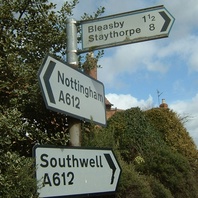
Viking Names
Bleasby
Bleasby, in the Thurgarton Wapentake of Nottinghamshire, was originally Blisetun, probably from the Old Norse male personal name Blesi and the Old English element tun ‘farm, settlement’. It was thus originally a hybrid name, like several others near it, such as Gonalston. By the thirteenth century, the second element had been replaced by Old Norse by ‘farm, settlement’.
Read More
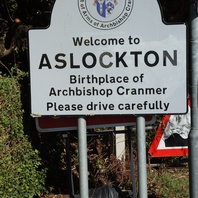
Viking Names
Aslockton
Aslockton, in the Bingham Wapentake of Nottinghamshire, comes from the Old Norse male personal name Áslákr and the Old English element tun ‘farm, settlement’. It is thus a hybrid name like others nearby, such as Thoroton and Colston Bassett.
Read More
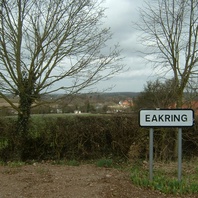
Viking Names
Eakring
Eakring, in the Bassetlaw Wapentake of Nottinghamshire, comes from the Old Norse elements eik ‘oak’ and hringr ‘ring’ and must have been named after a circle of oak trees.
Read More
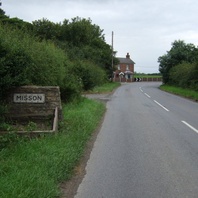
Viking Names
Misson
Misson, in the Bassetlaw Wapentake of Nottinghamshire, is a difficult name. It may be a river name, of which the first element has affinities with Danish mysse, Swedish myssene, or Old Norse mysni ‘a water-plant (?water-arum)’ either as a simplex name or combined with Old Norse á ‘a river’. Alternatively, the name might derive from Old English mos ‘a bog, a swamp; presumably also moss’.
Read More

Viking Names
Butti
Butti was a rare name in Scandinavia but is attested as an element in Norwegian place-names. It is also believed to be the first element of the place-name Budby, Nottinghamshire.
Read More
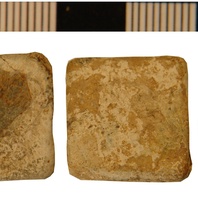
Viking Objects
Square Lead-Alloy Weight (NLM-941282)
Weights are an important form of evidence for Viking Age commerce and the use of standards across the different economic systems within which Vikings were integrated. Many of the weights discovered, particularly ones in Ireland and those of Arabic type, suggest that a standardized system of weights existed in some areas. These standard weights, alongside standard values of silver, are what allowed the bullion economy of Viking occupied areas to function. A bullion economy was a barter economy that relied on the exchange of set amounts of precious metal in various forms, such as arm-rings or coins, for tradable goods, such as food or textiles. Each merchant would have brought their own set of weights and scales to a transaction to make sure that the trade was conducted fairly.
Read More

Viking Names
Bild
The Old Norse male personal name Bíldr is originally a byname meaning ‘blade’. It is the personal name of a fictional character in West Scandinavia and is frequently used as a byname there. A Bildus is mentioned in Saxo and the name appears as a byname in Denmark and may be found in some Danish place-names. Bildr is the first element of the place-name of Bilsthorpe, Nottinghamshire.
Read More
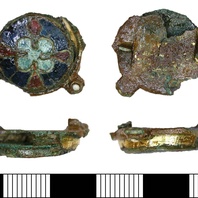
Viking Objects
Enamel Copper-Alloy Brooch (DENO-6C0D22)
This composite cast copper-alloy and enamel gilded brooch displays both Anglo-Scandinavian and Anglo-Saxon characteristics. The decorative enamel centre of the brooch was fabricated using a method known as cloisonné which involves the use of inlaid enamel cells, separated by strips of copper alloy, within an outer ring of copper alloy, all set upon a flat circular disc of copper alloy. The sides of the decorative roundel are surrounded with an upright strip of gilded copper alloy. The design of the enamel centre features a blue-green central quatrefoil, four cells which are shaped like elongated teardrops filled with red enamel giving the appearance of a cross motif, and four larger sub-rectangular cells filled with deep blue enamel. The brooch has been classified as Weetch Type 20. For more information on Scandinavian jewellery in England check out our blog: Brooches, Pendants and Pins: Scandinavian Dress Accessories in England.
Read More
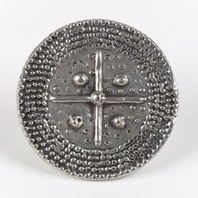
Viking Objects
Reproduction Lead Alloy Brooch
A reproduction of an early medieval, lead alloy brooch found at Barker Gate, Nottingham. Brooches were a typical part of female dress. Scandinavian brooches came in a variety of sizes and shapes which included disc, trefoil, lozenge, equal-armed, and oval shapes. The different brooch types served a variety of functions in Scandinavian female dress with oval brooches typically being used as shoulder clasps for apron-type dresses and the rest being used to secure an outer garment to an inner shift. Anglo-Saxon brooches do not match this diversity of form with large disc brooches being typical of ninth century dress styles with smaller ones becoming more popular in the later ninth and tenth centuries. However, since disc brooches were used by both Anglo-Saxon and Scandinavian women they are distinguished by their morphology. Scandinavian brooches were typically domed with a hollow back while Anglo-Saxon brooches were usually flat. Moreover, Anglo-Saxon brooches were worn singly without accompanying accessories.
Read More
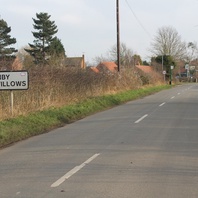
Viking Names
Barnby in the Willows
Barnby in the Willows, in the Newark Wapentake of Nottinghamshire, most likely comes from the Old Norse elements barn ‘child’ and by ‘farm, settlement’. Its meaning, ‘farmstead of the children’, may indicate joint inheritance by the offspring. Alternatively, the first element of the name could come from the Old Danish male personal name Barni. The affix is added at a later date and means ‘among the willow-trees’ and could be connected to its low location by the river Witham. The place-name has the same etymology as Barnby Moor, in the Bassetlaw Wapentake of Nottinghamshire.
Read More
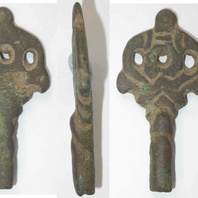
Viking Objects
Decorated Key (DENO-4259B3)
This cast copper-alloy key handle is decorated with Scandinavian-influenced designs reminiscent of the Urnes style of Viking art. Keys were not only practical items but also symbols of status. Women often carried the keys to the family’s chests of valuables. They also are often buried with keys, representing their authority in the household. See also the blog post on keys in the Viking Age.
